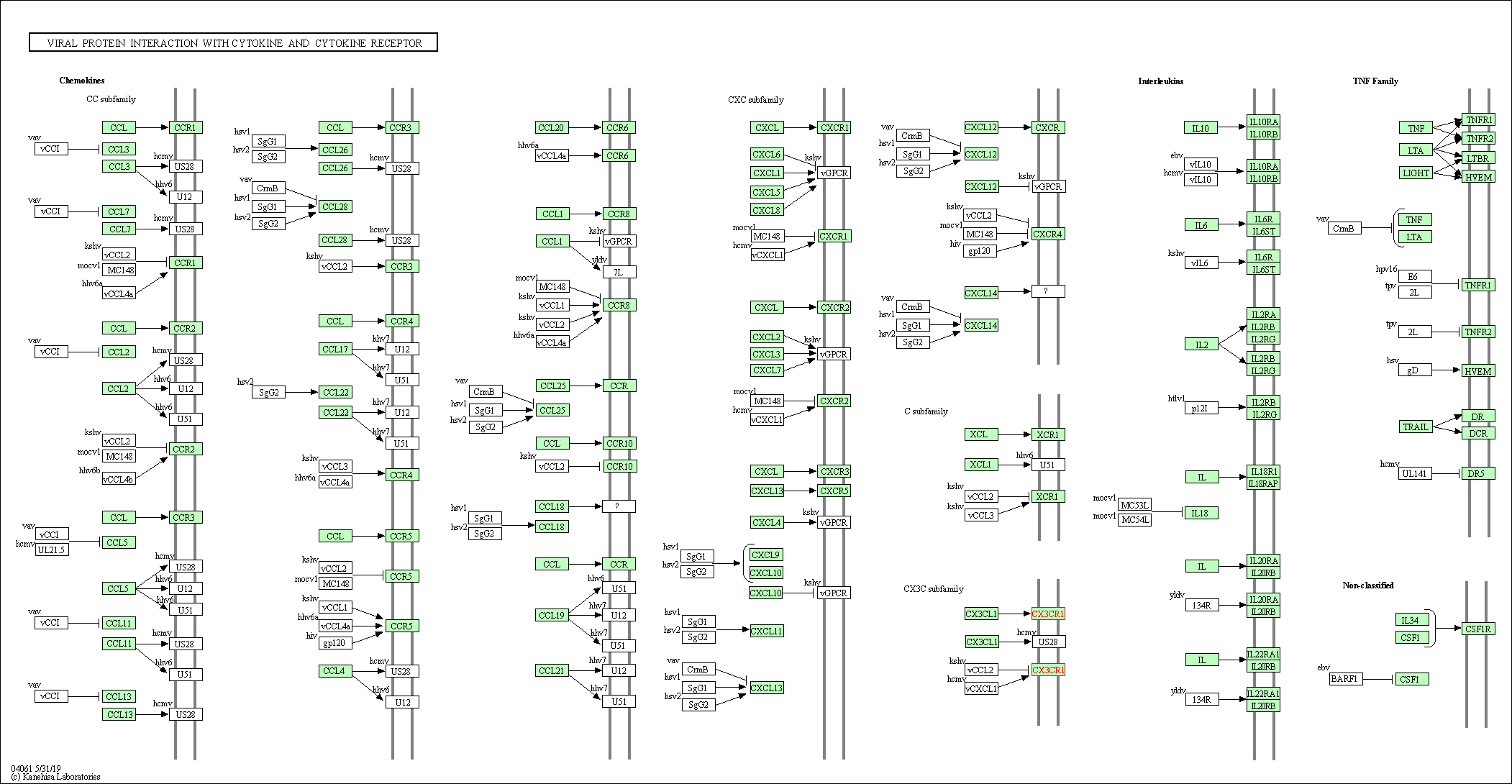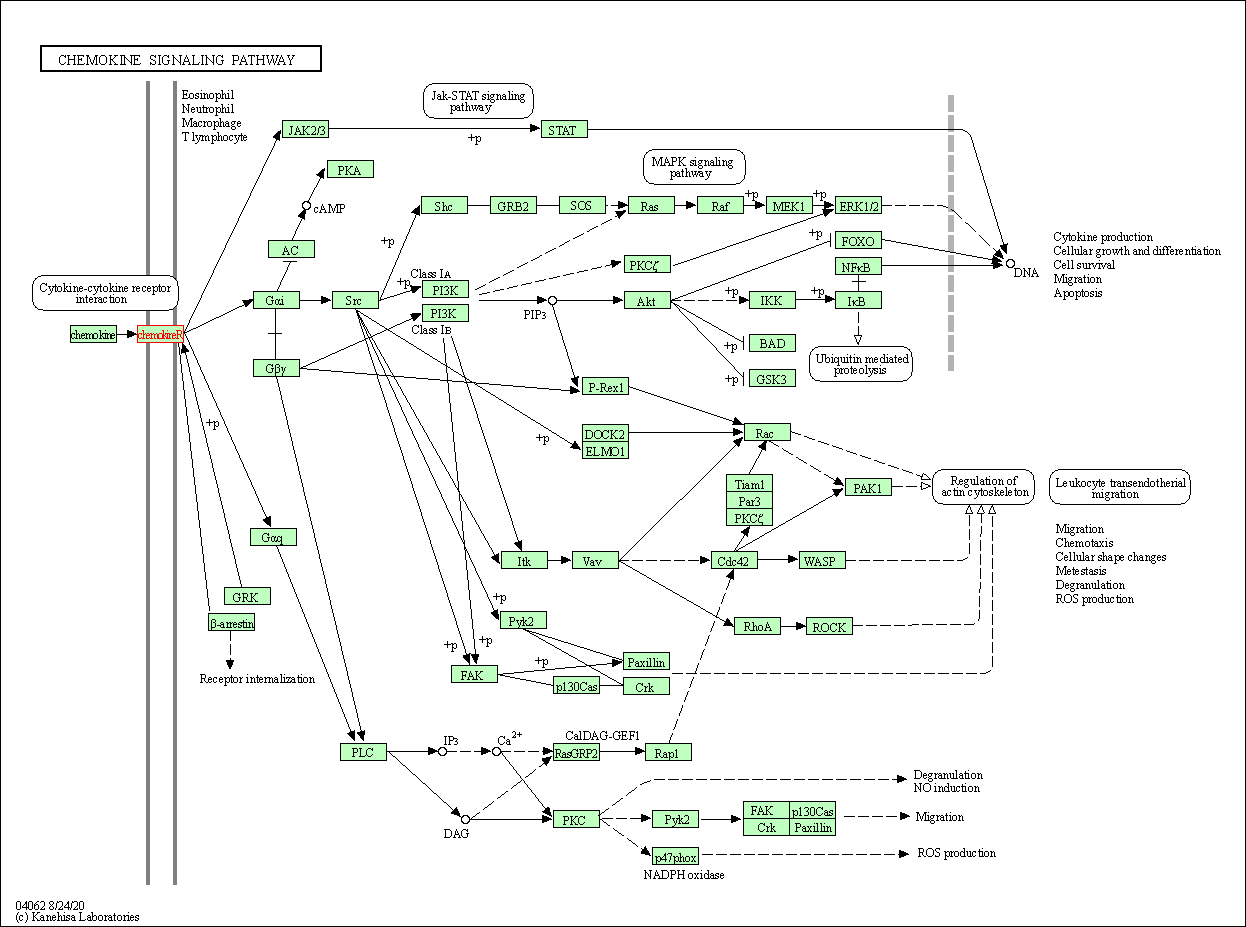Target Information
| Target General Information | Top | |||||
|---|---|---|---|---|---|---|
| Target ID |
T15033
(Former ID: TTDR00629)
|
|||||
| Target Name |
C-X3-C chemokine receptor 1 (CX3CR1)
|
|||||
| Synonyms |
V28; GPR13; G-protein coupled receptor 13; Fractalkine receptor CX3CR1; Fractalkine receptor; CX3C chemokine receptor 1; CMKBRL1; CMKBLR1; CMK-BRL1; CMK-BRL-1; C-X3-C CKR-1; Beta chemokine receptor-like1; Beta chemokine receptor-like 1
Click to Show/Hide
|
|||||
| Gene Name |
CX3CR1
|
|||||
| Target Type |
Literature-reported target
|
[1] | ||||
| Function |
Acts as coreceptor with CD4 for HIV-1 virus envelope protein (in vitro). Isoform 2 and isoform 3 seem to be more potent HIV-1 coreceptors than isoform 1. Receptor for the CX3C chemokine fractalkine (CX3CL1); binds to CX3CL1 and mediates both its adhesive and migratory functions.
Click to Show/Hide
|
|||||
| BioChemical Class |
GPCR rhodopsin
|
|||||
| UniProt ID | ||||||
| Sequence |
MDQFPESVTENFEYDDLAEACYIGDIVVFGTVFLSIFYSVIFAIGLVGNLLVVFALTNSK
KPKSVTDIYLLNLALSDLLFVATLPFWTHYLINEKGLHNAMCKFTTAFFFIGFFGSIFFI TVISIDRYLAIVLAANSMNNRTVQHGVTISLGVWAAAILVAAPQFMFTKQKENECLGDYP EVLQEIWPVLRNVETNFLGFLLPLLIMSYCYFRIIQTLFSCKNHKKAKAIKLILLVVIVF FLFWTPYNVMIFLETLKLYDFFPSCDMRKDLRLALSVTETVAFSHCCLNPLIYAFAGEKF RRYLYHLYGKCLAVLCGRSVHVDFSSSESQRSRHGSVLSSNFTYHTSDGDALLLL Click to Show/Hide
|
|||||
| 3D Structure | Click to Show 3D Structure of This Target | AlphaFold | ||||
| HIT2.0 ID | T08TXH | |||||
| Cell-based Target Expression Variations | Top | |||||
|---|---|---|---|---|---|---|
| Cell-based Target Expression Variations | ||||||
| Drug Binding Sites of Target | Top | |||||
|---|---|---|---|---|---|---|
| Ligand Name: Cholesterol | Ligand Info | |||||
| Structure Description | Cryo-EM structure of the human chemokine receptor CX3CR1 in complex with Gi1 | PDB:7XBW | ||||
| Method | Electron microscopy | Resolution | 2.80 Å | Mutation | Yes | [2] |
| PDB Sequence |
IGDIVVFGTV
32 FLSIFYSVIF42 AIGLVGNLLV52 VFALTNSKKP62 KSVTDIYLLN72 LALSDLLFVA 82 TLPFWTHYLI92 NEKGLHNAMC102 KFTTAFFFIG112 FFGSIFFLTV122 ISIDRYLAIV 132 LAANSMNNRT142 VQHGVTISLG152 VWAAAILVAA162 PQFMFTKQKE172 NECLGDYPEV 182 LQEIWPVLRN192 VETNFLGFLL202 PLLIMSYCYF212 RIIQTLFSSK222 NHKKAKAIKL 232 ILLVVIVFFL242 FWTPYNVVIF252 LETLKLYDFF262 PSCDMRKDLR272 LALSVTETVA 282 FSHCCLNPLI292 YAFAGEKFRR302 YLYHLYGK
|
|||||
|
|
ILE68
4.759
LEU71
4.094
ASN72
3.471
LEU75
3.599
LEU79
3.809
PHE108
4.584
ILE111
4.105
PHE118
3.626
THR121
4.219
VAL122
3.675
ILE125
4.290
THR142
4.167
VAL147
4.467
THR148
2.960
ILE149
4.118
SER150
3.443
LEU151
3.549
|
|||||
| Click to View More Binding Site Information of This Target with Different Ligands | ||||||
| Different Human System Profiles of Target | Top |
|---|---|
|
Human Similarity Proteins
of target is determined by comparing the sequence similarity of all human proteins with the target based on BLAST. The similarity proteins for a target are defined as the proteins with E-value < 0.005 and outside the protein families of the target.
A target that has fewer human similarity proteins outside its family is commonly regarded to possess a greater capacity to avoid undesired interactions and thus increase the possibility of finding successful drugs
(Brief Bioinform, 21: 649-662, 2020).
Human Pathway Affiliation
of target is determined by the life-essential pathways provided on KEGG database. The target-affiliated pathways were defined based on the following two criteria (a) the pathways of the studied target should be life-essential for both healthy individuals and patients, and (b) the studied target should occupy an upstream position in the pathways and therefore had the ability to regulate biological function.
Targets involved in a fewer pathways have greater likelihood to be successfully developed, while those associated with more human pathways increase the chance of undesirable interferences with other human processes
(Pharmacol Rev, 58: 259-279, 2006).
Biological Network Descriptors
of target is determined based on a human protein-protein interactions (PPI) network consisting of 9,309 proteins and 52,713 PPIs, which were with a high confidence score of ≥ 0.95 collected from STRING database.
The network properties of targets based on protein-protein interactions (PPIs) have been widely adopted for the assessment of target’s druggability. Proteins with high node degree tend to have a high impact on network function through multiple interactions, while proteins with high betweenness centrality are regarded to be central for communication in interaction networks and regulate the flow of signaling information
(Front Pharmacol, 9, 1245, 2018;
Curr Opin Struct Biol. 44:134-142, 2017).
Human Similarity Proteins
Human Pathway Affiliation
Biological Network Descriptors
|
|
| KEGG Pathway | Pathway ID | Affiliated Target | Pathway Map |
|---|---|---|---|
| Cytokine-cytokine receptor interaction | hsa04060 | Affiliated Target |

|
| Class: Environmental Information Processing => Signaling molecules and interaction | Pathway Hierarchy | ||
| Viral protein interaction with cytokine and cytokine receptor | hsa04061 | Affiliated Target |

|
| Class: Environmental Information Processing => Signaling molecules and interaction | Pathway Hierarchy | ||
| Chemokine signaling pathway | hsa04062 | Affiliated Target |

|
| Class: Organismal Systems => Immune system | Pathway Hierarchy | ||
| Degree | 1 | Degree centrality | 1.07E-04 | Betweenness centrality | 0.00E+00 |
|---|---|---|---|---|---|
| Closeness centrality | 1.07E-04 | Radiality | 3.98E-03 | Clustering coefficient | 0.00E+00 |
| Neighborhood connectivity | 1.00E+00 | Topological coefficient | . | Eccentricity | 1 |
| Download | Click to Download the Full PPI Network of This Target | ||||
| Chemical Structure based Activity Landscape of Target | Top |
|---|---|
| Target Regulators | Top | |||||
|---|---|---|---|---|---|---|
| Target-regulating microRNAs | ||||||
| References | Top | |||||
|---|---|---|---|---|---|---|
| REF 1 | Prevention of crescentic glomerulonephritis by immunoneutralization of the fractalkine receptor CX3CR1 rapid communication. Kidney Int. 1999 Aug;56(2):612-20. | |||||
| REF 2 | Activation of the human chemokine receptor CX3CR1 regulated by cholesterol. Sci Adv. 2022 Jul;8(26):eabn8048. | |||||
If You Find Any Error in Data or Bug in Web Service, Please Kindly Report It to Dr. Zhou and Dr. Zhang.

